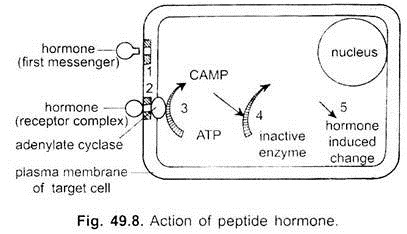In this article we will discuss about the endocrine glands in vertebrates with the help of a suitable diagram.
Elasmobranchii:
Elasmobranchs have most of the vertebrate endocrine glands. They are thyroid pituitary, adrenal tissue, pancreas, mucous membrane of stomach and duodenum, and gonads. There are no thymus and parathyroids as such. The functions of pituitary glands are not known except that it stimulates and keeps the glands healthy and it causes expansion of melanophores. The single thyroid lies below the anterior end of ventral aorta, it often has small ciliated cavity as a remainder of its origin from the endostyle.
The adrenal gland has two widely separate sets of tissues, the suprarental bodies or chromaffin cells are a segmental series of small glands along the autonomic ganglia some in the posterior cardinal sinus, some on each side of the oesophagus, and some in the kidneys.
The inter-renal bodies lie between the kidneys as single or paired glands. Each islet of Langerhans has prism-shaped cells around a cavity. Gonads contain endocrine glands which produce steroid hormones, testes have interstitial cells which secrete testosterone, ovaries have follicle cells producing estrogen and progesterone.
Amphibia:
ADVERTISEMENTS:
All the vertebrate endocrine glands are present. The relationship of the various lobes of the pituitary gland differs from that of higher vertebrates because the pars anterior and pars tuberalis do not form an anterior lobe, and pars anterior lies posterior to other lobes. Hormones of the pituitary cause maturation of the sex cells and control colour changes of the skin, intermedin causing expansion of melanophores.
Thyroid is paired and lies deeply, each thyroid lateral to the hyoid, its secretion besides controlling normal growth also brings about periodic ecdysis. Parathyroids are two pairs of small, red, round glands, one pair lying on each side of the posterior part of the hyoid. Thymus gland is formed from the second pair of visceral cleft. The two components of the adrenal glands are closely intermixed.
They form a yellow band on the ventral surface of each kidney. The endocrine part of gonads is definitely present but is a matter of conjecture because there are almost no interstitial cells in the testes. There are a few follicle cells in the ovaries around developing ova. The hormone of the testes during the breeding season causes formation of certain secondary sexual characters, such as changes in reproductive ducts and a swelling or copulatory pad on the thumb. There are no corpora lutea in ovaries.
Reptilia:
All vertebrate endocrine glands are present. Thyroid is a single gland in snakes and turtles but is paired in lizards and lies halfway below the trachea. It controls ecdysis. Parathyroids are two pairs at some distance posterior to the thyroid lying near the aortic arches. Pituitary gland lies somewhat posteriorly because the infundibular stalk is long, the anterior lobe is loosely connected in front to the other lobes, lizards and snakes have no pars distails. Adrenals lie close to gonads.
ADVERTISEMENTS:
The pineal gland registers solar radiations in lizards, and it probably secretes a hormone which regulates the behaviour with regard to temperature and plays a part in the control of reproduction. Gonads control the appearance of secondary sexual characters during the breeding season, such as changes in the skin pigmentation, and in males the formation of femoral glands and hemipenes. Interstitial cells are present in testes as endocrine glands. In those females which give birth to young ones corpora lutea appear in the ovaries for a successful completion of pregnancy. Follicle cells are present in the ovaries.
Aves:
All vertebrate endocrine glands are present. Thyroid glands are paired, one on each side of the trachea where it branches into bronchi. Thyroid secretes thyroxin which not only controls the general metabolic function but is also concerned with periodic moulting of feathers. Parathyroids are one or two small pairs in different birds, they lie slightly posterior to the thyroids. Pituitary gland has no intermediate lobe but intermedin is secreted by the anterior lobe.
Thymus is a pair of elongated glands, one on each side of the trachea. They are large in a young bird but much reduced in the adult. Adrenal glands are yellow-coloured and lie close to the gonads anterior to the kidney, the suprarenal tissue lies in crevices between masses of interregnal tissue.
Testes have extremely few interstitial cells but hormones are produced which control the functioning of the reproductive system and formation of secondary sexual characters, such as brighter colour of beaks and plumage, and in some the formation of a comb in the male. Ovaries have follicle cells as endocrine glands. But the formation of corpora lutea is doubtful in the single ovary of most birds.
